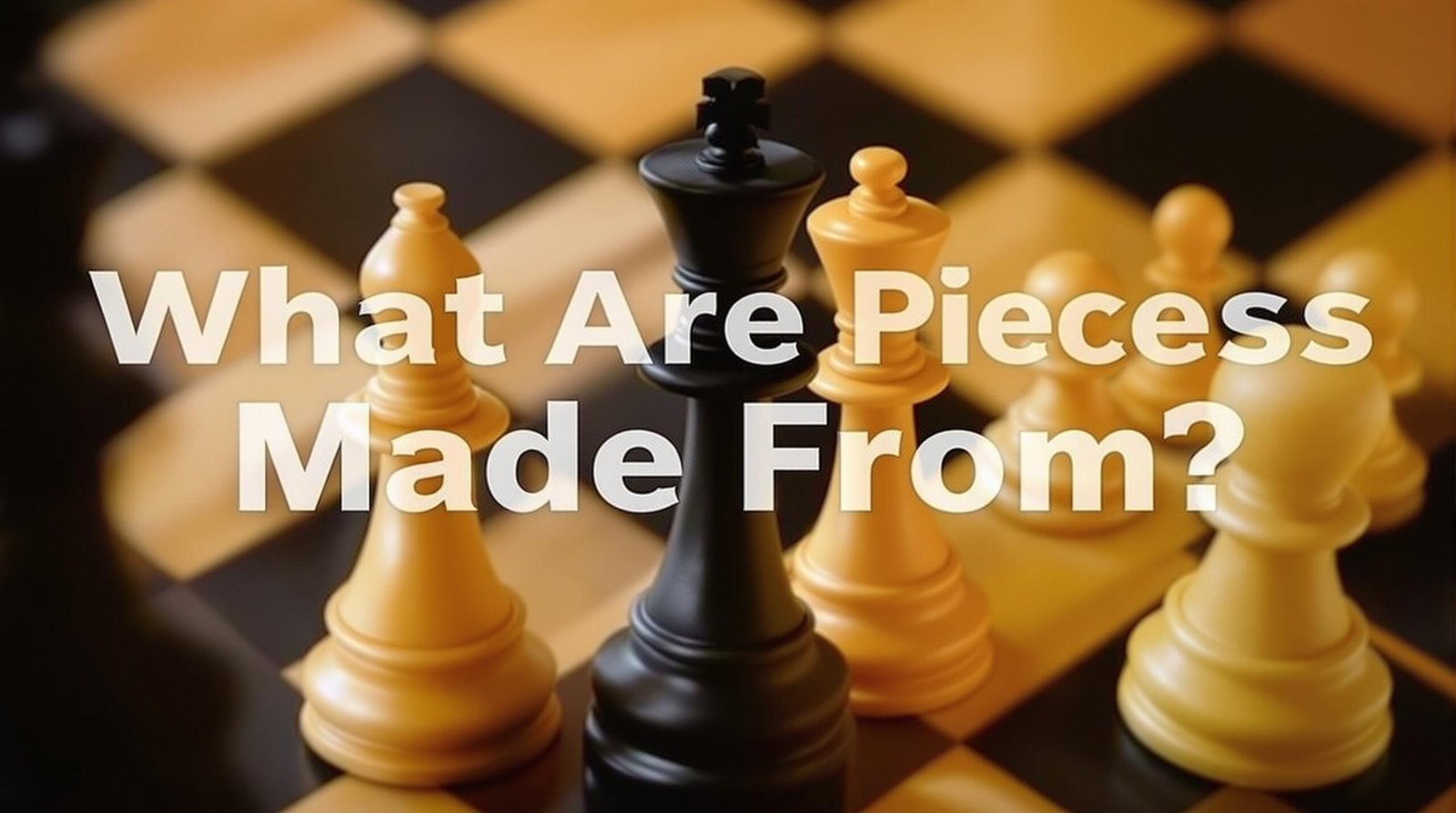
What are Chess Pieces Made From?

Chess, a game steeped in tradition and history, has captivated minds across the globe for centuries. While the strategic elements of the game often take centre stage, there’s a fascinating material history behind the physical pieces themselves. The craftsmanship and materials used to create chess pieces reflect not only aesthetic preferences but also cultural significance, availability of resources, and technological advancements throughout different eras and regions. From humble wooden sets to elaborate ivory masterpieces, the materials used in chess piece production tell a rich story of human creativity and adaptation.
Traditional Materials in Historical Chess Sets
Long before mass production, chess sets were crafted by skilled artisans using locally available materials. In medieval Europe, bone and ivory were highly prized materials for premium chess sets. The natural creamy hue of ivory provided an elegant contrast against darkened or naturally dark pieces, establishing the classic light-and-dark aesthetic that persists today. Ivory, primarily sourced from elephant tusks, was reserved for royalty and nobility due to its scarcity and the difficulty in working with it.
Wood has perhaps been the most enduring material in chess piece history. Various types of hardwoods such as ebony, rosewood, and boxwood offered durability and a pleasing feel in the hand. European craftsmen typically used boxwood for white pieces, appreciating its fine grain and smooth texture, whilst ebony, with its deep, rich black colouring, served perfectly for the opposing side. In regions where these specific woods weren’t readily available, local alternatives were employed, often stained or treated to achieve the desired contrast.
In parts of the Islamic world, where representational art faced religious restrictions, abstract chess pieces emerged, often crafted from stone, particularly alabaster and marble. These materials allowed for intricate geometric patterns and smooth, tactile forms that adhered to Islamic artistic traditions whilst maintaining the functionality required for gameplay.
The Rise of Staunton: Standardisation in Chess Piece Design
The mid-19th century marked a pivotal moment in chess piece design with the introduction of the Staunton pattern in 1849. Named after English chess master Howard Staunton, this design standardised the appearance of chess pieces, creating a style that remains the official tournament standard today. The original Staunton sets were crafted from boxwood and ebony, though the design principles could be applied to any material.
Jaques of London, the company that first produced Staunton chess sets, used primarily high-quality woods, but also offered luxury versions in bone and ivory. The standardisation of design coincided with advancements in turning techniques and machinery, allowing for more consistent production whilst maintaining exceptional craftsmanship. These sets featured weighted bases, often filled with lead, providing stability during play—a feature that remains desirable in quality chess sets today.
The introduction of the Staunton design also democratised chess to some extent, as manufacturers could now produce sets that were more affordable whilst maintaining a dignified aesthetic and practical playability. This period saw a broadening of materials used, as manufacturers sought to create sets at various price points whilst adhering to the established design principles.
Modern Materials: Innovation and Sustainability
The 20th century witnessed significant shifts in chess piece production, driven by both technological advancements and changing attitudes toward material sourcing. Plastic emerged as a revolutionary material for chess pieces, particularly after World War II. Bakelite, an early synthetic plastic, offered durability and the ability to mimic more expensive materials at a fraction of the cost. Later, thermoplastics provided even greater flexibility in production, allowing for detailed moulding and consistent quality.
Today, plastic chess sets dominate the market, particularly for tournament and school use, where durability and cost-effectiveness are paramount. High-quality vinyl roll-up boards with plastic pieces have become standard for chess clubs and schools, combining practicality with affordability. These sets often feature weighted plastic pieces with felt bottoms, providing a satisfying heft and protecting playing surfaces.
For those seeking premium sets, wood remains the material of choice, with boxwood, rosewood, ebony, and sheesham being particularly popular. Manufacturers have increasingly turned to sustainable forestry practices, responding to environmental concerns about overharvesting of slow-growing species like ebony. Some high-end producers now utilise wood from certified sources or explore alternative species that can be finished to resemble traditional materials.
The ban on ivory trade has eliminated new ivory chess sets from legitimate markets, reflecting changing ethical standards regarding wildlife conservation. In response, artisans have developed alternatives that capture ivory’s aesthetic appeal without the ethical concerns. High-grade polyresin and bone composites can replicate the look and feel of ivory, whilst some craftsmen work with fossilised mammoth ivory—a legal alternative sourced from remains of long-extinct mammoths found in permafrost regions.
Exotic and Luxury Materials in Contemporary Chess Sets
For collectors and enthusiasts with substantial budgets, the world of luxury chess sets offers an astonishing array of materials. Precious metals have long been used in high-end sets, with silver and gold-plated pieces representing the pinnacle of opulence. Some exclusive sets feature solid silver pieces, often contrasted with gold-plated counterparts, creating a dazzling display of wealth and craftsmanship.
Semi-precious and precious stones have found their way into chess set design, with materials like jade, marble, onyx, and lapis lazuli offering unique colouration and a cool, substantial feel in the hand. These stone sets often feature meticulous hand-carving, combining the natural beauty of the material with the artisan’s skill. Some extraordinary examples utilise contrasting stones, such as white carrara marble against green jade or black onyx.
Crystal and glass chess sets have carved out their own niche in the luxury market. Leading crystal manufacturers like Baccarat and Waterford have produced spectacular sets, exploiting the refractive properties of fine crystal to create pieces that seem to capture and transform light. Frosted and clear glass combinations offer a modern aesthetic whilst maintaining the traditional contrast between opposing sides.
For truly bespoke creations, some artisans work with unusual organic materials such as antler, horn, or even exotic woods like amboyna burl or thuya root, prized for their distinctive grain patterns. These materials often require specialised knowledge and techniques, resulting in one-of-a-kind sets that command extraordinary prices amongst collectors.
The Science and Technology Behind Modern Chess Piece Production
Contemporary chess piece production ranges from traditional handcrafting to advanced manufacturing techniques. In high-volume production, injection moulding dominates, allowing for consistent quality and intricate details in plastic pieces. The process involves injecting molten plastic into precisely engineered moulds under high pressure, creating perfectly formed pieces that require minimal finishing.
For wooden pieces, computer-controlled lathes have revolutionised production whilst maintaining the natural appeal of wood. These machines can reproduce the same design with remarkable precision, ensuring uniformity across pieces. However, many premium wooden sets still involve significant handwork, particularly in finishing stages where craftspeople apply stains, polishes, and protective coatings.
Advancements in material science have led to innovations like weighted chess pieces. Today’s quality sets often contain internal weights—typically made of steel or lead—to provide stability and a satisfying heft. The weight is usually secured within the piece using felt or baize discs, which also protect playing surfaces and provide smooth, silent movement.
The finishing of chess pieces has also benefited from technological progress. UV-resistant coatings protect wooden pieces from discolouration, whilst advanced polymer finishes can provide water and damage resistance without compromising the material’s natural beauty. For plastic pieces, anti-wear compounds ensure longevity even with frequent use.
Cultural Variations in Chess Piece Materials
Different chess traditions around the world have favoured particular materials and designs. Russian chess sets, particularly those in the Soviet tradition, often feature intricate painted wooden pieces, with red and black frequently replacing the traditional brown/black contrast. These sets typically showcase detailed hand-painting, with artists employing techniques passed down through generations.
In India, where chess originated in its earliest form as chaturanga, camel bone has been a traditional material for fine chess sets. Artisans in regions like Rajasthan still craft exquisite pieces from ethically sourced bone, often embellished with intricate painted details or inlays of contrasting materials.
Chinese chess sets, whilst representing a related but distinct game (Xiangqi), demonstrate alternative approaches to materials. Traditional sets use flat discs of hardwood with engraved characters, though jade, soapstone, and even bamboo pieces can be found in various regional styles.
In Northern Europe, particularly Iceland and Scandinavia, walrus ivory (from archaeological sources) has historical significance in chess piece production. The famous Lewis Chessmen, discovered on the Isle of Lewis in Scotland but believed to be of Norwegian origin, were carved from walrus ivory and whale teeth in the 12th century, demonstrating the use of locally available materials in this seafaring culture.
Environmental and Ethical Considerations
The materials used in chess pieces have increasingly come under ethical scrutiny. The ban on new ivory through CITES (Convention on International Trade in Endangered Species) regulations has effectively ended the production of new ivory chess sets, though antique sets remain legal in many jurisdictions. This has pushed manufacturers and consumers toward more sustainable alternatives.
Exotic hardwoods face similar challenges, with species like ebony appearing on conservation watchlists due to overharvesting. Responsible manufacturers now seek certification from organisations like the Forest Stewardship Council (FSC), ensuring their wood comes from sustainably managed forests. Some have pivoted to using more abundant species that can be stained or treated to resemble rarer woods.
The environmental impact of plastic chess pieces has also come under consideration. While plastic offers durability and affordability, concerns about microplastics and petroleum-based production have led some manufacturers to explore bioplastics derived from renewable resources like corn or sugarcane. These materials offer similar performance characteristics whilst reducing the carbon footprint of production.
For consumers concerned about ethical sourcing, reclaimed or recycled materials present an attractive option. Some artisans specialise in creating chess sets from repurposed materials—from industrial metal scraps fashioned into modernist designs to reclaimed exotic woods given new life as chess pieces. These approaches combine environmental consciousness with unique aesthetic qualities that mass-produced sets cannot match.
The Future of Chess Piece Materials
Looking forward, the materials used in chess pieces will likely continue to evolve, reflecting both technological advancements and changing cultural values. 3D printing has already begun to influence chess set design, allowing for complex geometries and customisation previously impossible with traditional manufacturing techniques. As this technology matures, we may see increasingly sophisticated printed chess sets using composite materials that mimic the weight and feel of traditional sets whilst offering unprecedented design freedom.
Research into sustainable alternatives to traditional materials continues to advance. New composites combining natural fibres with biodegradable binders could potentially offer the aesthetic appeal of wood with enhanced durability and consistency. Meanwhile, advancements in synthesising materials that mimic the look and feel of ivory without ethical concerns may satisfy collectors seeking that classic aesthetic.
The growing interest in smart chess technology suggests another direction for chess piece materials. Pieces incorporating sensors or magnetic elements to interact with electronic boards may become more common, requiring materials that balance traditional aesthetics with technological functionality. These developments might bridge the gap between physical chess sets and digital chess platforms, creating new hybrid experiences for players.
Whatever the future holds, the rich material history of chess pieces reminds us that the physical experience of the game—the weight of a piece in hand, the sound as it contacts the board, the visual contrast between opposing forces—remains central to chess’s enduring appeal. As new materials emerge and manufacturing techniques advance, they will undoubtedly be judged against these timeless qualities that have defined the game’s tactile pleasure for centuries.





